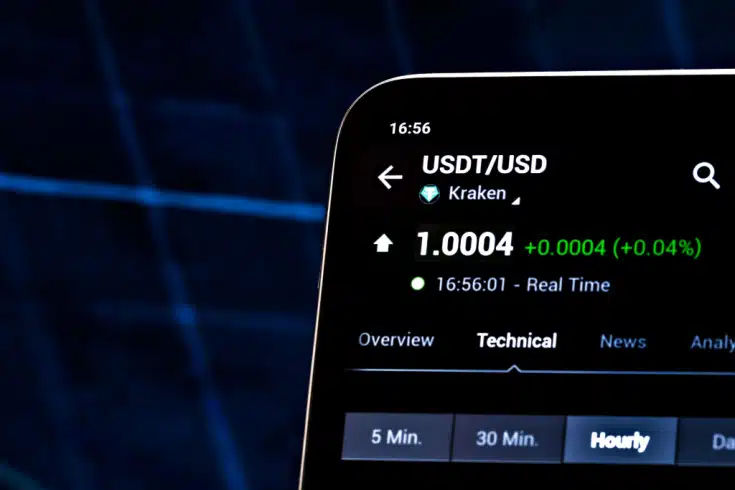Types, Laws, and Regulations of Stablecoins

Stablecoins are issued with legal tender such as dollars or yen as the underlying asset and are designed to maintain a table value unlike highly volatile crypto assets (virtual currencies) such as Bitcoin. Funds Settlement Law in Japan, which was revised in 2022, stipulates regulations for stablecoins for the first time.
In this article, we will focus on the correlation between stablecoins and electronic payment methods according to the 2020 revised Payment Services Act[ja].
Stablecoins
A stablecoin is a type of cryptocurrency that is designed to maintain a stable value when compared to other assets or baskets of assets.
Stablecoins such as Tether (USDT), DAI, AMPL, and JPYC (JPY Coin) are commonly used.
Stablecoins has distinct attributes in comparison to traditional cryptocurrencies.
Stable coins stand out for their stable value, unlike other crypto assets that are known for their high volatility in prices.
Crypto currencies were mainly regulated as payment instruments, but the issue arises of whether stablecoins should be classified as currencies, payment instruments, or financial instruments.
Moreover, even though there are no specific guidelines for cryptoasset issuers, there remains uncertainty over whether stablecoins can be accommodated within the existing legal framework.
Stablecoins has distinctive features that distinguish them from conventional cryptocurrencies.
Types of Stablecoins
Depending on the type of asset to which their value is linked, stablecoins are typically classified into the following categories.
| Fiat currency collateral type | Stablecoins issued with legal currencies such as US dollars and yen as underlying assets |
| Crypto-assets collateral type | Stablecoins issued backed by crypto assets such as BTC and ETH |
| Algorithmic (unsecured) type | A stable coin that adjusts supply and demand with an algorithm on the blockchain |
| Basket currency type | A stablecoin that has multiple legal currencies as underlying assets and is issued at a weighted average price based on the holding ratio of each legal currency |
| Commodity collateral type | Stablecoins issued backed by certain commodities such as gold and oil |
Stablecoin Laws and Regulations

The regulations on stablecoins vary depending on their contents. Therefore, we will provide an overview of the laws and regulations governing stablecoins.
Positioning of Stablecoins under Current Law
Stablecoins can be classified into two categories: digital currency-like and crypto-asset-like.
Stablecoins, similar to digital currency, are issued at a fixed price that is linked to the value of legal tender, such as 1 coin being equal to 1 yen. These coins are guaranteed to be redeemed at the same price they were issued at.
According to current laws, this stablecoin, which resembles digital currency, will be considered an asset denominated in currency.
In contrast, crypto-assets of this nature are those that utilize algorithms to maintain a stable value.
According to current laws, this stablecoin categorized as a type of crypto-asset.
Currency Denominated Assets and Crypto Assets
Currency-denominated assets are defined as follows (Article 2, Paragraph 6 of Japan’s Payment Services Act).
(6) The term “currency-denominated assets” as used in this Act means assets which are denominated in the Japanese currency or a foreign currency, or for which performance of obligations, refund, or anything equivalent thereto (hereinafter referred to as “performance of obligations, etc.” in this paragraph) is supposed to be made in the Japanese currency or a foreign currency. In this case, assets for which performance of obligations, etc. is supposed to be made by means of currency-denominated assets are deemed to be currency-denominated assets.
On the other hand, crypto assets are defined as follows (Article 2, Paragraph 5 of Japan’s Payment Services Act).
(5) The term “crypto-assets” as used in this Act means any of the following; provided, however, that those indicating electronically recorded transferable rights prescribed in Article 2, paragraph (3) of the Financial Instruments and Exchange Act (Act No. 25 of 1948) are excluded:
(i) property value (limited to that which is recorded on an electronic device or any other object by electronic means, and excluding the Japanese currency, foreign currencies, and currency-denominated assets; the same applies in the following item) which can be used in relation to unspecified persons for the purpose of paying consideration for the purchase or leasing of goods or the receipt of provision of services and can also be purchased from and sold to unspecified persons acting as counterparties, and which can be transferred by means of an electronic data processing system; and
(ii) property value which can be mutually exchanged with what is set forth in the preceding item with unspecified persons acting as counterparties, and which can be transferred by means of an electronic data processing system.
As it is evident, assets denominated in currency are not included in the definition of crypto assets.
According to current law, stablecoins are divided into two categories: those that correspond to currency-denominated assets and those that correspond to crypto assets. It’s worth noting that stablecoins classified as currency-denominated assets are not considered as crypto-assets.
According to current laws, stablecoins that are not categorized as crypto assets exist.
Prepaid Payment Instruments and Currency-Denominated Assets
Prepaid payment instruments are defined as follows (Article 3, Paragraph 1 of the Payment Services Act of Japan).
Article 3(1)The term “prepaid payment instruments” as used in this Chapter means any of the following instruments:
(i) certificates, electronic devices, or other items (hereinafter referred to as “certificates, etc.” in this Chapter) or numbers, markings, or other signs (including additions to the amount recorded in the certificate, etc. by electronic or magnetic means in exchange for the receipt of consideration equivalent to the additional amount recorded) issued in exchange for the receipt of consideration equivalent to the amount (if the amount is found each time to be converted to and indicated as an amount indicated in another unit, include the number of that unit; the same applies hereinafter in this item and in paragraph (3)) recorded in the certificate, etc. or recorded using electronic or magnetic means (meaning in electronic form, magnetic form, or any other form that is impossible to perceive by the human senses alone; the same applies hereinafter in this paragraph) which can be used for the purpose of paying consideration for the purchase or leasing of goods or the receipt of provision of services from the issuer or the person designated by the issuer (referred to as the “issuer, etc.” in the following item) by way of presentation, delivery, notification, or other means;
(ii) certificates, etc. or numbers, markings, or other signs issued in exchange for the receipt of consideration equivalent to the quantity of goods or services recorded in the certificate, etc. or recorded using electronic or magnetic means (including additions to the quantity of goods or services recorded in the certificate, etc. by electronic or magnetic means in exchange for the receipt of consideration equivalent to the recorded additional quantity) which can be used for the purpose of claiming the delivery or provision of those goods or services from the issuer, etc. by way of presentation, delivery, notification, or other means.
In order to be acknowledged as prepaid payment instruments under the Payment Services Act of Japan, Article 3, Paragraph 1 identifies the following necessary elements:
- Description or recording of property value, including amount and quantity (value preservation)
- Issuance of a certificate, number, etc. in exchange for corresponding consideration to the amount, quantity, etc. (consideration issuance)
- Exercise of rights to pay consideration to a specific person (rights utilization)
Taking into account the aforementioned factors, prepaid payment instruments could potentially be classified as currency-denominated assets.
It should be noted that there is ongoing debate regarding the general classification of prepaid payment instruments as currency-denominated assets.
Forex Trading and Currency-Denominated Assets
Regarding foreign exchange transactions, the Supreme Judgment of March 12, 2001, page 97, Vol. 55, No. 2, states as follows.
“Foreign exchange transaction…” means accepting or executing a request from a customer to transfer funds using a mechanism that transfers funds without directly transporting cash between remote parties.
In the context of finance, the term “funds” encompasses money and assets that can be readily converted into cash, such as deposits and foreign currency. Consequently, stablecoins that are categorized as crypto assets are typically not recognized as a viable medium for exchange transactions. (Notwithstanding, an exception may be made for stablecoins that can be redeemed for cash.)
Stablecoins, categorized as assets denominated in currency, are generally considered to fall within foreign exchange transactions when issued or redeemed.
The issuer of stablecoin, a currency-denominated asset, will be subject to banking and fund transfer regulations. However, it is believed that intermediaries will not be subject to such regulations.
Positioning of Stablecoins under Revised Payment Services Act of 2022

As per the amended Payment Services Act of 2022, stablecoins that resemble digital money will be subject to regulation under the category of “electronic payment instruments.”
The Payment Services Act Amendment of 2022 stands out with its regulatory framework that governs distinct business models for “issuers” and “intermediaries.”
Electronic Payment Methods
Electronic payment methods are defined in Article 2, Paragraph 5 of the 2022 Amendment to the Payment Services Act.
“Electronic payment means” as used in this Act means the following:
1. When purchasing or renting goods, etc., or receiving provision of services, it can be used for unspecified persons to pay for these prices, and purchased with unspecified persons as the other party and property values that can be sold and that can be transferred using an electronic data processing system (excluding those listed in item (iii)).
(This is limited to currency-denominated assets that are electronically recorded on electronic devices, etc. In addition, securities, Electronically Recorded Monetary Claims Act (Act No. 102 of 2007), Article 2, Paragraph 1 Electronically Recorded Monetary Claims, Prepaid Payment Instruments prescribed in Article 3, paragraph (1), or similar items specified by Cabinet Office Ordinance (excluding those specified by Cabinet Office Ordinance in consideration of liquidity and other circumstances) excluding. The same shall apply in the next issue.)
2. Property value that can be mutually exchanged with the items listed in the preceding item with an unspecified person as the other party, and that can be transferred using an electronic information processing system (corresponding to the items listed in the following item excluding things.)
3 Specific trust beneficiary right
The requirements for item 1 above can be summarized as follows.
- Can be used to pay the price to an unspecified person, and can be mutually exchanged with an unspecified person.
- Recorded electronically and is transferable
- Currency-denominated assets (distinction from crypto assets)
- Securities, Electronically Recorded Monetary Claims, Prepaid Payment Instruments, and other similar items specified by Cabinet Office Ordinance (excluding those specified by Cabinet Office Ordinance in consideration of marketability and other circumstances)
- Must not fall under Specified Trust Beneficiary Rights (Item 3)
Stablecoins that are considered currency-denominated assets, resembling digital currency, are recognized as electronic payment methods.
In principle, prepaid payment instruments cannot be refunded in cash due to their definition. Therefore, they are not typically classified as electronic payment instruments. However, depending on their specific characteristics, they may still be classified as such.
Electronic Payment Method Business Operators
Article 2, Paragraph 10 of the revised Payment Services Act stipulates electronic payment method business operators as follows.
(Article 2, Paragraph 10 of the Amended Payment Services Act)
“Electronic payment means transaction business” as used in this law means any of the following acts as a business. “Exchange, etc. of electronic payment means” means the acts listed in Item 1 or Item 2, and “Management of electronic payment means” means the acts listed in Item 3.
1. Purchase and sale of electronic payment means or exchange with other electronic payment means
2. Mediation, brokerage or agency for the acts listed in the preceding item
3. To manage electronic payment means for others (excluding those specified by Cabinet Office Ordinance as those that are less likely to lack user protection, taking into consideration the content, etc.).
4. Upon being entrusted by a Funds Transfer Service Provider, the user (concluding a contract with the Funds Transfer Service Provider to continuously or repeatedly conduct exchange transactions on behalf of the Funds Transfer Service Provider) (Limited to those who have a financial position)) to conduct any of the following matters by using an electronic information processing system, and based on the agreement, the amount of claims related to exchange transaction obligations to increase or decrease
B Transfer funds based on the contract, and the debt related to exchange transactions equivalent to the amount of the funds
As an operator of an electronic payment method business, it is imperative that you take necessary measures to protect the users and prevent money laundering. It is also important to remain vigilant about potential future regulatory developments.
Positioning of Stablecoins in Revised Payment Services Act
Stable coins that use a crypto-asset algorithm to stabilize their value are classified as crypto-assets and subject to regulation. However, stablecoins that function like digital currency and promise redemption at the issue price are considered electronic payment methods.
When it comes to crypto assets, there are currently no legal restrictions imposed on issuers. However, electronic payment instruments are subject to certain limitations. Businesses seeking to issue stablecoins should carefully weigh the expenses associated with complying with these regulations.
Stablecoins are subject to varying regulations based on their nature, thus it is important to exercise caution.
Consult a Lawyer for Legal Issues with Stablecoins
We have outlined the connection between stablecoins and electronic payment systems as per the revised Payment Services Act, catering to individuals and business operators dealing in stablecoin-related businesses.
Crypto-asset-based stablecoins will be subjected to regulatory oversight as crypto-assets, while digital currency-based stablecoins will be monitored as electronic payment methods.
If you plan to engage in stablecoin-related business, it’s important to note that regulations require expertise in both legal matters and knowledge of stablecoins and cryptoassets. Therefore, we suggest seeking advice from a lawyer with specialized knowledge to ensure compliance with regulations.
Guidance on Countermeasures by Our Office
Monolith Law Office is a law firm that possesses extensive expertise in both IT, particularly the Internet, and law. Our firm offers comprehensive support for companies involved with crypto assets and blockchain.
Category: IT





















